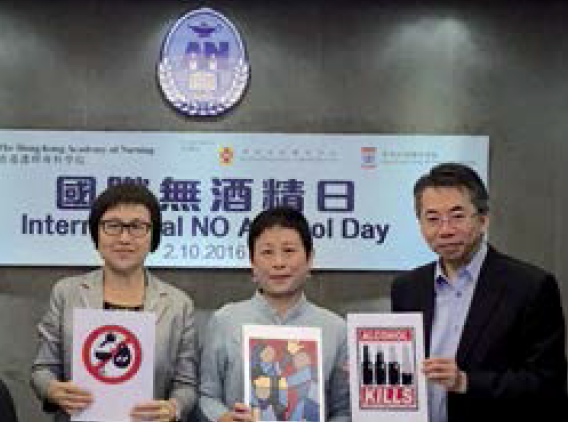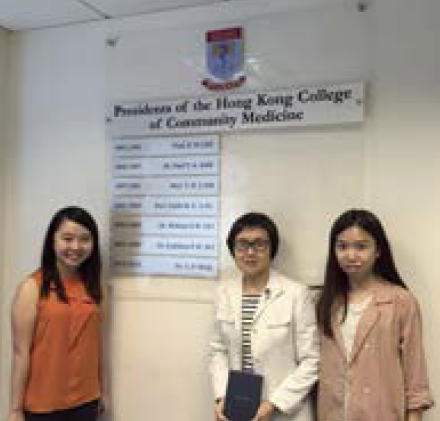© Hong Kong Academy of Medicine. CC BY-NC-ND 4.0
DOCTOR FOR SOCIETY
Behind the silver plaque…the never-ceasing
passion: an interview with Dr Sin-ping Mak
Rachel SW Yiu1; Suki SY Ho2
1 Year 6 (MB, BS/PhD), The University of Hong Kong
2 Year 4 (MB, ChB), The Chinese University of Hong Kong
On the pale beige wall a plaque reads “2010-2014
Dr. S. P. Mak”. It was a silver plaque, with the names
of past presidents of the Hong Kong College of
Community Medicine, hanging under the logo of
the College. Rays of sunlight projected onto the wall
through the office window while the silver preserved
its usual subtlety, without giving off a dazzling
blaze—it seemed to echo with our featured doctor:
Dr SP Mak, a humble and distinguished local leader
in the field of Community Medicine.
Two months ago, you might have recognised Dr
Mak in the newspaper on ‘International NO Alcohol
Day’, calling on the public and the government to
enhance actions to reduce alcohol-related harm.
Dr Mak is one of the founders and the
Convener of the Hong Kong Alliance for Advocacy
Against Alcohol (HKAAAA). Set up in July 2015, it is
a non-governmental alliance affiliated with the Hong
Kong College of Community Medicine. It plays an
advocacy role and engages with the community
to discourage alcohol consumption. Members
are recruited from the academic, medical and
health, social, and educational sectors. Combining
expertise from these different professions, the
HKAAAA conducts research, formulates evidence-based
policy suggestions, and empowers the public
by education. Through mass media channels and
public campaigns, the HKAAAA promotes public
awareness of the detrimental effects of drinking on
health and socio-economics.
“While there has been much achievement in
tobacco control, comparatively little has been done
when it comes to alcohol,” commented Dr Mak.
She recalled that in the past, tobacco was
common and popular, penetrating all social classes.
With the implementation of various public health
policies and regulations, including taxation and
restrictions on advertising, as well as educational
campaigns about the harm and carcinogenic risk of
tobacco, the prevalence of smoking in Hong Kong
has dropped significantly. Although alcohol is also
a group 1 carcinogen with other well-established
detrimental effects on health, it has not received
equal attention and caution. Dr Mak believes that
more vigorous actions are needed to fight alcohol, and
that it requires conjoint efforts and support from the
government and the community at large. Nowadays,
alcohol is more a symbol of status on social occasions
than a hazard. This perception is especially popular
among adolescents. A survey by the Security Bureau
in 2014 that targeted primary and secondary school
students revealed that over 40% of the respondents
consumed alcohol in that year. More recently, a
telephone survey of 1000 people conducted by the
HKU Public Opinion Programme, and initiated by
the Hong Kong College of Community Medicine
and the Hong Kong Medical Association, showed
that 77% of the respondents agreed that alcohol
should not be sold at retail outlets to those under
18. A similar percentage of people were in support
of a mandatory health warning on containers of
alcoholic beverages. Nonetheless, support from the
public alone is not sufficient. Dr Mak is well aware
that alcohol policies affect the vested interests of
multiple parties, therefore making advocacy work
in the local setting difficult. She gave the example of
the lifting of alcohol import duty by Government in
2008 that she considered the single most anti–public
health policy. In addition, Dr Mak reflected upon the
relatively loose regulation of alcohol sales in Hong
Kong compared with elsewhere. For example, those
under 18 in Hong Kong can easily buy beer and wine
at convenience stores or supermarkets despite a ban
on selling alcohol to them in licensed restaurants;
alcohol can be sold at any time as long as retail shops
are open, unlike in some countries where alcohol can
be sold only during restricted hours.
“These are but a few examples borrowed from
overseas practices that can discourage the public to
consume alcohol,” added Dr Mak.
Although HKAAAA started small, Dr Mak
demonstrated to us her unwavering determination
and enthusiasm for the future work of the Alliance.
The Convener of HKAAAA is only one of
Dr Mak’s many active voluntary roles that she has
assumed on various boards and councils since her
retirement in 2008. She gives lectures and tutorials
to students in the two local medical schools as an
Honorary Associate Professor and an Adjunct
Professor, and is involved in training younger
doctors at the Hong Kong College of Community
Medicine. Prior to her retirement, Dr Mak served
in the Government for over 30 years, with work
ranging from health policy formulation to health
services planning, infectious diseases, and drug and
food safety control. She is a remarkable leader in the
field and served as the Vice President and President
of the Hong Kong College of Community Medicine
from 1997 to 2014. Clearly, Dr Mak’s impressive
enthusiasm in promoting public health post-retirement
stems from her long history of dedication
to the betterment of people’s health. What remains
enigmatic is what made her seed sprout and kept it
growing in this specialty, i.e. Community Medicine,
since the first day of her career.
When Dr Mak was asked about the most
memorable and rewarding piece of work in her
career, she recalled the planning and establishment
of the first Public Health Laboratory Centre in
Hong Kong in 2002. Located at Nam Cheong Street,
Shek Kip Mei, it remains the only one of its kind
in Hong Kong. Prior to its establishment, public
health laboratories were located in scattered places
in hospitals and even clinics. They were small and
unable to meet the required health and safety
standards, not to mention coping with public health
demand should a large-scale local disease outbreak
occur. Spearheaded by Dr Mak, a team of experts
in microbiology, architecture, and engineering
united to oversee the project. The Centre came into
operation just in time to fight the SARS (severe acute
respiratory syndrome) outbreak the following year,
one of the hardest periods of time for Hong Kong.
Looking back, Dr Mak was glad to see the facility
weather such a significant health storm in Hong
Kong with its enhanced capability, and the services
have now won global and international acclaim.
While we were listening in awe to her story,
Dr Mak tested our memory of the “Upstream River
Model” that we once learnt during the junior years at
medical school. She used it to explain to us her view
of the role of a doctor in Community Medicine.
“Our mission is to prevent diseases of the
population by acting upstream. This is a long-term
goal.”
“To achieve this, we have to establish a robust
doctor-community relationship, not merely a
doctor-patient relationship as in other specialties.”
Perhaps a more obscure side of Dr Mak is her
‘hidden’ titles of “LLB” and “LLM”. Immediately after
her retirement, she pursued two degrees in Law
and Arbitration and Dispute Resolution, just for
interest. We asked if she has ever wanted to change
her career. She revealed that she preferred medicine
to law as medicine has a warmer, people-oriented
nature. She nonetheless benefitted a lot from both
law programmes, especially the communication
skills learnt that are most useful in establishing
trusting relationships with the community at large.
Reflecting on her past achievements in the field of
Community Medicine and the complexities behind
her work that frequently involved multiple parties
within and outside the medical profession, Dr Mak’s
eagerness to learn in life and her warm, loving
character are perhaps her two greatest assets that
have watered and nurtured the seed to fruition since
the first day of her journey in Community Medicine.
On Public Health, “It promises little fame or
fortune. But it does have one big thing going for it:
the opportunity to make a significant—often life-saving—difference in people’s lives,” said Kathleen Sebelius, former Secretary of Health and Human
Services of the United States. “To improve public
health, we have to commit, we have to know the
community,” summarised Dr Mak.
It might be hard to imagine working in a
field where one can save somebody’s life with no
acknowledgement of one’s efforts; where the greatest
rewards are not easily visible. Yet this is the case
with Dr Mak. After this interview, we might not
remember every word of Dr Mak, but the image of
the subtle silver plaque in her office will be deeply
imprinted in our minds as we continue to learn to be
good doctors for society.

(right) Dr Mak pictured with Prof Frances Wong (centre) and Dr Angus Chan (right) during the event of ‘International NO Alcohol Day’


